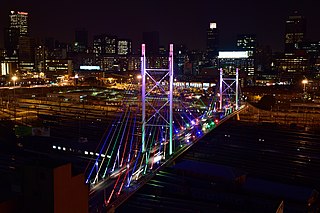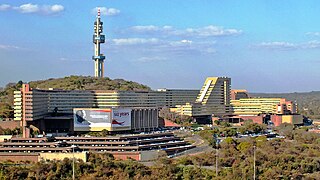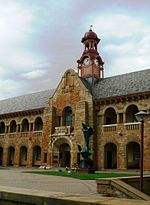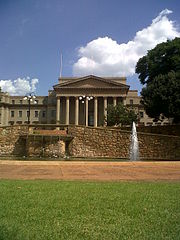
Pretoria is South Africa's administrative capital, serving as the seat of the executive branch of government, and as the host to all foreign embassies to South Africa.

Johannesburg is the most populous city in South Africa, classified as a megacity; it is one of the 100 largest urban areas in the world. According to Demographia, the Johannesburg–Pretoria urban area is the 26th-largest in the world in terms of population, with 14,167,000 inhabitants. It is the provincial capital and largest city of Gauteng, which is the wealthiest province in South Africa. Johannesburg is the seat of the Constitutional Court, the highest court in South Africa. Most of the major South African companies and banks have their head offices in Johannesburg. The city is located within the mineral-rich Witwatersrand hills, the epicentre of the international-scale mineral, gold and (specifically) diamond trade.

The Province of the Transvaal, commonly referred to as the Transvaal, was a province of South Africa from 1910 until 1994, when a new constitution subdivided it following the end of apartheid. The name "Transvaal" refers to the province's geographical location to the north of the Vaal River. Its capital was Pretoria, which was also the country's executive capital.

Gauteng is one of the nine provinces of South Africa.

The University of the Witwatersrand, Johannesburg, commonly known as Wits University or Wits, is a multi-campus public research university situated in the northern areas of central Johannesburg, South Africa. The university has its roots in the mining industry, as do Johannesburg and the Witwatersrand in general. Founded in 1896 as the South African School of Mines in Kimberley, it is the third oldest South African university in continuous operation.
The Technikon Witwatersrand was a technikon located in Johannesburg, South Africa. On 1 January 2005, it merged with Rand Afrikaans University and the Soweto and East Rand campuses of Vista University to form the University of Johannesburg. The former Vista University East Rand Campus has subsequently been permanently closed.
The following lists events that happened during 1910 in South Africa.

The State Artillery Regiment is a reserve artillery regiment of the South African Army.

The University of South Africa (UNISA) is the largest university system in South Africa by enrollment. It attracts a third of all higher education students in South Africa. Through various colleges and affiliates, UNISA has over 400,000 students, including international students from 130 countries worldwide, making it one of the world's mega universities and the only such university in Africa.

Kya Rosa is a beautifully decorated late-Victorian house at the main entrance to the University of Pretoria in Pretoria, South Africa.
The University of Pretoria Faculty of Law was established in 1908. It consists of six academic departments, six centres, two law clinics, and the Pretoria University Law Press (PULP). This faculty ranked best in Africa for the fourth year in a row with leading Departments of Jurisprudence; Mercantile Law; Private Law; Procedural Law; Public Law; and Centre for Human Rights. The faculty offers the undergraduate LLB degree, and postgraduate LLM/MPhil and LLD/PhD degrees.

The University of Pretoria is a multi-campus public research university in Pretoria, the administrative and de facto capital of South Africa. The university was established in 1908 as the Pretoria campus of the Johannesburg-based Transvaal University College and is the fourth South African institution in continuous operation to be awarded university status. The university has grown from the original 32 students in a single late Victorian house to approximately 53,000 in 2019. The university was built on seven suburban campuses on 1,190 hectares.

The campuses of the University of the Witwatersrand, Johannesburg contain a number of notable buildings. There are five campuses: East Campus and West Campus are located in Braamfontein on opposite sides of the M1 highway, while the Education Campus and the Medical and Management schools are located in Parktown.
The University of Pretoria Faculty of Engineering, the Built Environment and Information Technology educational programs stretch back to 1908 and consists of the School of Engineering, School for the Built Environment, School of Information Technology and the Graduate School of Technology Management. The university is the only African collaborator in the CDIO engineering initiative: Since 1997, the university as a whole has produced more research outputs every year than any other institution of higher learning in South Africa, as measured by the Department of Education's accreditation benchmark.
The Old School of Mines building in Hull Street, Kimberley, is where the South African School of Mines was established in 1896, later evolving into the Transvaal University College, and eventually into both the University of the Witwatersrand and the University of Pretoria. In 1904 the school was moved to Johannesburg, becoming the Transvaal Technical Institute which, in turn, was renamed the Transvaal University College in 1906. The separation of Johannesburg and Pretoria campuses in 1910 paved the way for establishment of the Universities of the Witwatersrand (1922) and of Pretoria (1930).

The Gauteng Division of the High Court of South Africa is a superior court of law which has general jurisdiction over the South African province of Gauteng and the eastern part of North West province. The main seat of the division is at Pretoria, while a local seat at Johannesburg has concurrent jurisdiction over the southern parts of Gauteng. Dunstan Mlambo has been the Judge President of the division since 1 November 2012.
The following is a timeline of the history of Pretoria, in the City of Tshwane Metropolitan Municipality, Gauteng province, South Africa.
This page details the South African Army order of battle in 1940, before and after the formation of expeditionary forces.

















